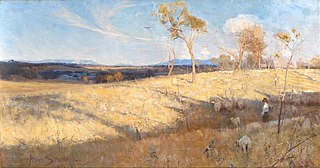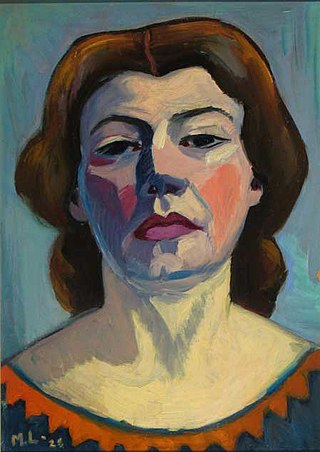
Impressionism was a 19th-century art movement characterized by relatively small, thin, yet visible brush strokes, open composition, emphasis on accurate depiction of light in its changing qualities, ordinary subject matter, unusual visual angles, and inclusion of movement as a crucial element of human perception and experience. Impressionism originated with a group of Paris-based artists whose independent exhibitions brought them to prominence during the 1870s and 1880s.

The Heidelberg School was an Australian art movement of the late 19th century. It has been described as Australian impressionism.

American Impressionism was a style of painting related to European Impressionism and practiced by American artists in the United States from the mid-nineteenth century through the beginning of the twentieth. The style is characterized by loose brushwork and vivid colors with a wide array of subject matters but focusing on landscapes and upper-class domestic life.

Frederick Ronald Williams was an Australian painter and printmaker. He was one of Australia’s most important artists, and one of the twentieth century's major landscapists. He had more than seventy solo exhibitions during his career in Australian galleries, as well as the exhibition Fred Williams - Landscapes of a Continent at the Museum of Modern Art in New York in 1977.
George Milwa Mnyaluza Pemba was a South African painter and writer. He was posthumously awarded the Order of Ikhamanga.

Orovida Pissarro, known for most of her life as Orovida, was a British painter and etcher. For most of her career she distanced herself from the Impressionist and Post-Impressionist styles of her father, Lucien Pissarro and grandfather, Camille Pissarro, in favour of a technique influenced by Chinese and other Asiatic art; but in the last quarter of her career developed a manner which drew on both traditions.
Peter Clarke was a South African visual artist working across a broad spectrum of media. He was also a writer and poet.

James Lavadour is an American painter and printmaker. A member of the Walla Walla tribe, he is known for creating large panel sets of landscape paintings. Lavadour is the co-founder of the Crow's Shadow Institute of the Arts.
I believe that a painting must stand up on its own without explanation. I think of myself as an abstract action painter. I just happen to see landscape in the abstract events of paint. - James Lavadour

Edith Dimock was an American painter. Her work was exhibited at the 1913 Armory Show in New York. She married fellow artist, William Glackens, but continued to use her maiden name professionally after the marriage.
California Tonalism was art movement that existed in California from circa 1890 to 1920. Tonalist are usually intimate works, painted with a limited palette. Tonalist paintings are softly expressive, suggestive rather than detailed, often depicting the landscape at twilight or evening, when there is an absence of contrast. Tonalist paintings could also be figurative, but in them, the figure was usually out of doors or in an interior in a low-key setting with little detail.

Maria Magdalena Laubser was a South African painter and printmaker. She is generally considered, along with Irma Stern, to be responsible for the introduction of Expressionism to South Africa. Her work was initially met with derision by critics but has gained wide acceptance, and now she is regarded as an exemplary and quintessentially South African artist.

Esther Mahlangu is a South African artist. She is known for her bold large-scale contemporary paintings that reference her Ndebele heritage. She is one of South Africa's best known artists.

Springtime or The Reader is an 1872 painting by the French Impressionist painter Claude Monet. It depicts his first wife, Camille Doncieux, seated reading beneath a canopy of lilacs. The painting is presently held by the Walters Art Museum.

Penny Siopis is a South African artist from Cape Town. She was born in Vryburg in the North West province from Greek parents who had moved after inheriting a bakery from Siopis maternal grandfather. Siopis studied Fine Arts at Rhodes University in Makhanda, completing her master's degree in 1976, after which she pursued postgraduate studies at Portsmouth Polytechnic in the United Kingdom. She taught Fine Arts at the Technikon Natal in Durban from 1980 to 1983. In 1984 she took up a lectureship at the University of the Witwatersrand in Johannesburg. During this time she was also visiting research fellow at the University of Leeds (1992–93) and visiting professor in fine arts at Umeå University in Sweden (2000) as part of an interinstitutional exchange. With an honorary doctorate from Rhodes University, Makhanda – Siopis is currently honorary professor at Michaelis School of Fine Art, University of Cape Town.

Baya Mahieddine or Fatima Haddad was an Algerian artist. While she did not identify her work as belonging to a particular art genre, critics have classified her paintings as surrealist, primitive, naïve, and modern. She was an entirely self-taught artist, working both as a painter and, to a lesser extent, in pottery.
Lisa Brice is a South African painter and visual artist from Cape Town. She lives in London and cites some of her influences as her experiences growing up in South Africa during a time of political upheaval, and from time spent living and working in Trinidad.

Gabrielle Valerie Hyacinthe Hope was a New Zealand painter known for her watercolours and drawings. Her work consists of still lives, landscapes, portraits, and works featuring animals. She preferred to sign her works simply as "GABRIELLE."
Mmakgabo Mmapula Mmangankato Helen Sebidi is a South African artist born in Marapyane (Skilpadfontein) near Hammanskraal, Pretoria, who lives and works in Johannesburg. Sebidi's work has been represented in private and public collections, including at the National Museum of Women in the Arts, Washington and New York, the Smithsonian National Museum of African Art, New York, and the World Bank. Her work has been recognised internationally and locally. In 1989, she won the Standard Bank Young Artist award, becoming the first black woman to win the award. In 2004, President Thabo Mbeki awarded her the Order of Ikhamanga in Silver – which is the highest honor given to those considered a "national treasure". In 2011, she was awarded the Arts and Culture Trust (ACT) Lifetime Achievement Award for Visual Art, while in 2015 she received the Mbokodo Award. In September 2018, Sebidi was honoured with one of the first solo presentations at the Norval Foundation in Cape Town – a retrospective entitled Batlhaping Ba Re.

Gladys Goldstein was an American artist who lived and worked within the art community of Baltimore, Maryland. Having begun as a representational artist specializing in portraits, she achieved recognition first for abstractions that were clearly based on natural forms and later for abstractions whose origin in natural forms was imperceptible. She was known for her deft handling of light and color in these works: atmospheric and subtle in some of them, intense and garish in others. Some critics saw an impressionist impulse in her paintings while others noted an expressionist ability to imbue them with emotion. In 1958 a critic said, "In nature Mrs. Goldstein finds a constant change in mood through patterns, rhythms, color; flamboyant now, wistfully delicate tomorrow; light, light that is reflected, light that is absorbed, light that is charged with the buoyancy of champagne or as quietly, morosely romantic, as any passage of Baudelaire." Goldstein chose to be a regional artist. She occasionally exhibited elsewhere but did not actively promote her career outside a mid-Atlantic region centered on Baltimore. She taught art for most of her long career, first in classes held in community centers and later in Baltimore's College of Notre Dame.
Aileen Lipkin (1933–1994) was a prominent South African artist.














